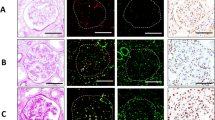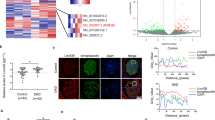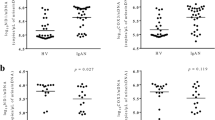Abstract
The number of chronic kidney disease (CKD) patients is increasing worldwide, and it is necessary to diagnose CKD patients in earlier stages to improve their prognosis. Previously, in a study using human samples, we reported that DNA methylation and DNA damage in podocytes are potential markers for kidney function decline in IgA nephropathy; however, these candidate markers have not been adequately investigated in other glomerular diseases. Here, we report that the association of podocyte DNA damage and DNA methylation with eGFR decline and proteinuria differs depending on the type of glomerular disease. Patients diagnosed with minor glomerular abnormality (MGA, n = 33), membranous nephropathy (MN, n = 9) or diabetic nephropathy (DN, n = 10) following kidney biopsy at Keio University Hospital from 2015 to 2017 were included. In MGA patients, both podocyte DNA damage and glomerular DNA methylation were associated with the severity of proteinuria. In DN patients, podocyte DNA double-strand breaks (DSBs) and glomerular DNA methylation were associated with an eGFR decline. When patients with urinary protein levels of more than 1 g/gCr were examined, fewer podocyte DNA DSBs were detected in MN patients than in MGA patients, and the level of glomerular DNA methylation was lower in MN patients than in MGA or DN patients. These results indicate that investigating podocyte DNA DSBs and DNA methylation changes may be useful for understanding the pathogenesis of CKD with proteinuria in humans.

This study suggested the association of podocyte DNA damage and subsequent DNA methylation with proteinuria in minor glomerular abnormalities (MGA) patients and those with eGFR declines in diabetic nephropathy (DN) patients, respectively.
This is a preview of subscription content, access via your institution
Access options
Subscribe to this journal
Receive 12 print issues and online access
$259.00 per year
only $21.58 per issue
Buy this article
- Purchase on Springer Link
- Instant access to full article PDF
Prices may be subject to local taxes which are calculated during checkout





Similar content being viewed by others
References
Bikvov B, Purcell CA, Levey AS, Smith M, Abdoli A, Abebe M, et al. Global, regional, and national burden of chronic kidney disease, 1990-2017: a systematic analysis for the Global Burden of Disease Study 2017. Lancet. 2020;395:709–33. https://doi.org/10.1016/s0140-6736(20)30045-3
Diez-Sampedro A, Lenz O, Fornoni A. Podocytopathy in diabetes: a metabolic and endocrine disorder. Am J Kidney Dis. 2011;58:637–46. https://doi.org/10.1053/j.ajkd.2011.03.035
Palmer MB, Abedini A, Jackson C, Blady S, Chatterjee S, Sullivan KM, et al. The role of glomerular epithelial injury in kidney function decline in patients with diabetic kidney disease in the TRIDENT cohort. Kidney Int Rep. 2021;6:1066–80. https://doi.org/10.1016/j.ekir.2021.01.025
Hayashi K, Sasamura H, Nakamura M, Azegami T, Oguchi H, Sakamaki Y, et al. KLF4-dependent epigenetic remodeling modulates podocyte phenotypes and attenuates proteinuria. J Clin Investig. 2014;124:2523–37. https://doi.org/10.1172/jci69557
Hayashi K, Sasamura H, Nakamura M, Sakamaki Y, Azegami T, Oguchi H, et al. Renin-angiotensin blockade resets podocyte epigenome through Kruppel-like Factor 4 and attenuates proteinuria. Kidney Int. 2015;88:745–53. https://doi.org/10.1038/ki.2015.178
Hishikawa A, Hayashi K, Abe T, Kaneko M, Yokoi H, Azegami T, et al. Decreased KAT5 expression impairs DNA repair and induces altered DNA methylation in kidney podocytes. Cell Rep. 2019;26:1318–32.e1314 https://doi.org/10.1016/j.celrep.2019.01.005.
Hayashi K, Hishikawa A, Hashiguchi A, Azegami T, Yoshimoto N, Nakamichi R, et al. Association of glomerular DNA damage and DNA methylation with one-year eGFR decline in IgA nephropathy. Sci Rep. 2020;10:237 https://doi.org/10.1038/s41598-019-57140-0
Yu BC, Cho N, Park S, Kim H, Gil H, Lee EY, et al. Minor glomerular abnormalities are associated with deterioration of long-term kidney function and mitochondrial injury. J Clin Med. 2019;9. https://doi.org/10.3390/jcm9010033.
Hoshino Y, Kaga T, Abe Y, Endo M, Wakai S, Tsuchiya K, et al. Renal biopsy findings and clinical indicators of patients with hematuria without overt proteinuria. Clin Exp Nephrol. 2015;19:918–24. https://doi.org/10.1007/s10157-015-1090-6
Hishikawa A, Hayashi K, Yoshimoto N, Nakamichi R, Homma K, Itoh H. DNA damage and expression of DNA methylation modulators in urine-derived cells of patients with hypertension and diabetes. Sci Rep. 2020;10:3377. https://doi.org/10.1038/s41598-020-60420-9
Matsuo S, Imai E, Horio M, Yasuda Y, Tomita K, Nitta K, et al. Revised equations for estimated GFR from serum creatinine in Japan. Am J Kidney Dis. 2009;53:982–92. https://doi.org/10.1053/j.ajkd.2008.12.034
Boucquemont J, Heinze G, Jager KJ, Oberbauer R, Leffondre K. Regression methods for investigating risk factors of chronic kidney disease outcomes: the state of the art. BMC Nephrol. 2014;15:45. https://doi.org/10.1186/1471-2369-15-45
Hayashi K, Sasamura H, Ishiguro K, Sakamaki Y, Azegami T, Itoh H. Regression of glomerulosclerosis in response to transient treatment with angiotensin II blockers is attenuated by blockade of matrix metalloproteinase-2. Kidney Int. 2010;78:69–78. https://doi.org/10.1038/ki.2010.81
Kohda Y, Murakami H, Moe OW, Star RA. Analysis of segmental renal gene expression by laser capture microdissection. Kidney Int. 2000;57:321–31. https://doi.org/10.1046/j.1523-1755.2000.00824.x
Cohen CD, Grone HJ, Grone EF, Nelson PJ, Schlondorff D, Kretzler M. Laser microdissection and gene expression analysis on formaldehyde-fixed archival tissue. Kidney Int. 2002;61:125–32. https://doi.org/10.1046/j.1523-1755.2002.00112.x
Furda AM, Bess AS, Meyer JN, Van HB. Analysis of DNA damage and repair in nuclear and mitochondrial DNA of animal cells using quantitative PCR. Methods Mol Biol. 2012;920:111–32. https://doi.org/10.1007/978-1-61779-998-3_9
Maslov AY, Ganapathi S, Westerhof M, Quispe-Tintaya W, White RR, Houten BV, et al. DNA damage in normally and prematurely aged mice. Aging Cell. 2013;12:467–77. https://doi.org/10.1111/acel.12071
Hayashi K, Hishikawa A, Itoh H. DNA damage repair and DNA methylation in the kidney. Am J Nephrol. 2019;50:81–91. https://doi.org/10.1159/000501356
Acknowledgements
We acknowledge Dr. Hideaki Nakaya for providing assistance during the initial stage of this study. This study was supported by Grants for Scientific Research (22H03091, 20H00535, and 19K08688) from the Ministry of Education, Culture, Sports, Science and Technology (MEXT) of Japan; Keio University Research Grants for Life Science and Medicine; the Naito Memorial Foundation; the Takeda Science Foundation; and the Mochida Memorial Foundation for Medical and Pharmaceutical Research, Tokyo, Japan.
Author information
Authors and Affiliations
Contributions
NY performed the experiments, analyzed the data, and wrote the manuscript. KH conceived and designed the research study, analyzed, and interpreted the data, and wrote the manuscript. AHa supported the pathological evaluations and revised the manuscript. AHi, RN, ES, EY, TA and TN contributed to the drafting and revision of the manuscript. HI supervised the entire project and edited the manuscript.
Corresponding author
Ethics declarations
Conflict of interest
The authors declare no competing interests.
Additional information
Publisher’s note Springer Nature remains neutral with regard to jurisdictional claims in published maps and institutional affiliations.
Supplementary information
Rights and permissions
Springer Nature or its licensor (e.g. a society or other partner) holds exclusive rights to this article under a publishing agreement with the author(s) or other rightsholder(s); author self-archiving of the accepted manuscript version of this article is solely governed by the terms of such publishing agreement and applicable law.
About this article
Cite this article
Yoshimoto, N., Hayashi, K., Hishikawa, A. et al. Significance of podocyte DNA damage and glomerular DNA methylation in CKD patients with proteinuria. Hypertens Res 46, 1000–1008 (2023). https://doi.org/10.1038/s41440-023-01169-2
Received:
Revised:
Accepted:
Published:
Issue Date:
DOI: https://doi.org/10.1038/s41440-023-01169-2
Keywords
This article is cited by
-
Nucleic acid and protein methylation modification in renal diseases
Acta Pharmacologica Sinica (2024)



